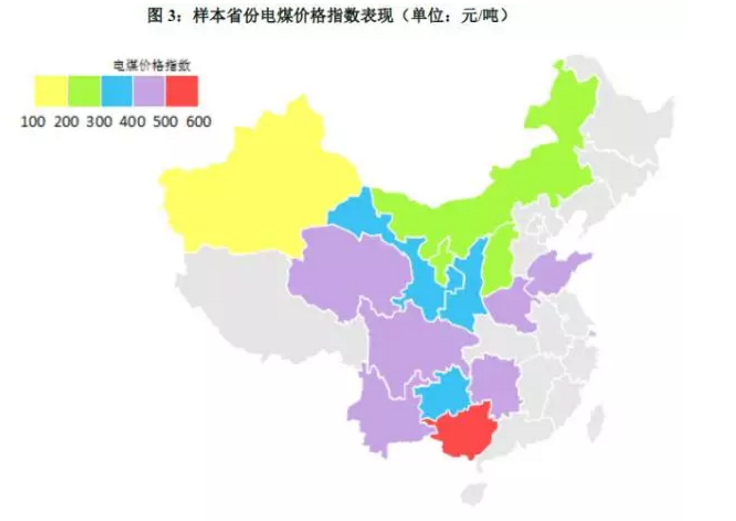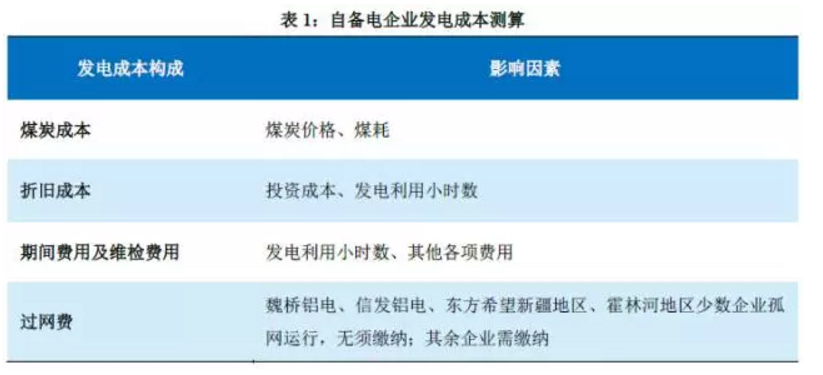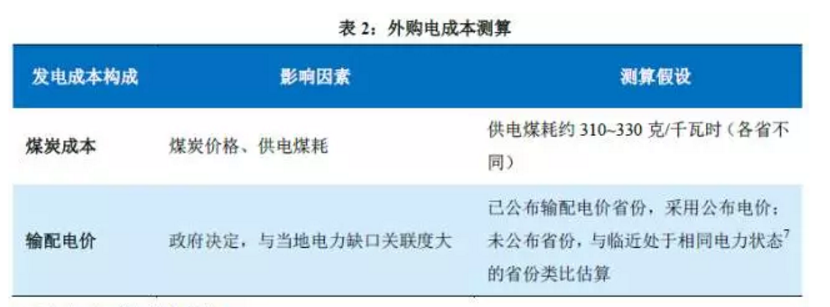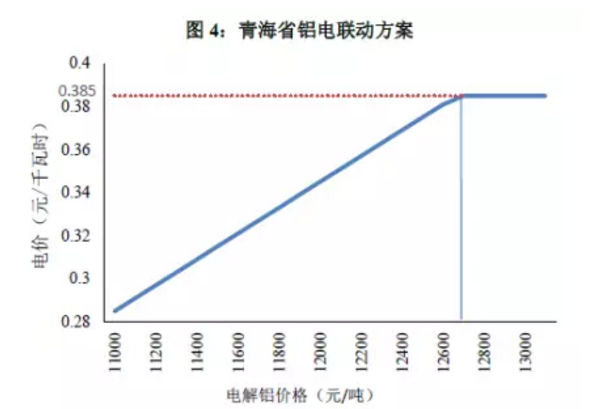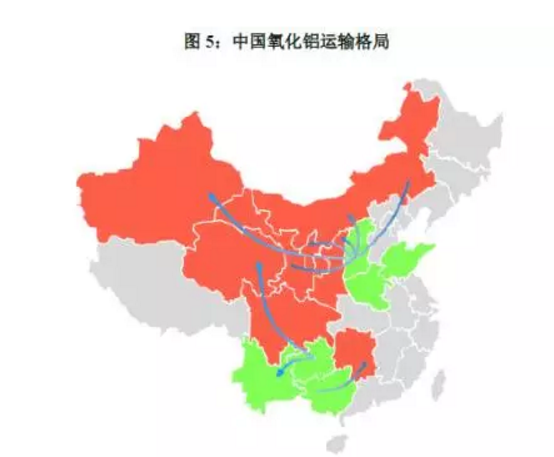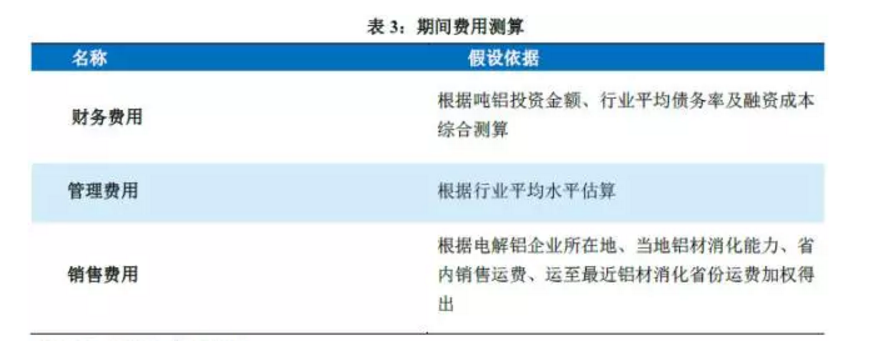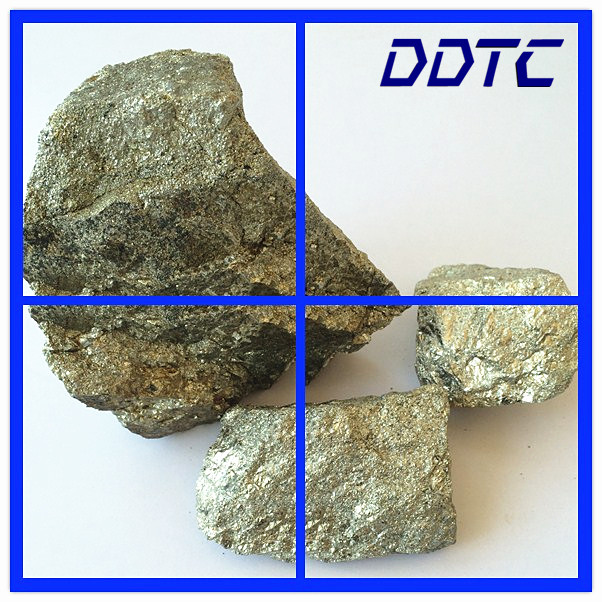In 1954, the first phase of aluminum production at Fushun Aluminum Plant in China was put into production. In the past 60 years, the electrolytic aluminum industry in China has been making rapid progress. In 2003, it became the world’s largest electrolytic aluminum production area, and now it has occupied the world’s electrolytic aluminum. Half of the industry. At the same time, the development of the industry has spawned many large electrolytic aluminum producers: Shandong, Xinjiang, Inner Mongolia, and Henan. The ever-changing industrial structure, the increasingly fierce cost game, and the constantly changing regional competitiveness. This paper selects 14 provinces of electrolytic aluminum production in China, in order to introduce the status of regional electrolytic aluminum industry, quantify the regional cost differentiation in 2017, and predict the future development potential of each region. Based on their respective endowments and upstream and downstream industrial structures, electricity cost, alumina self-sufficiency and transportation, downstream sales, and local government policies are the most important factors in differentiating regional competitiveness. This article measures the production costs (including electricity costs, alumina costs, anode carbon block costs, and manufacturing costs) and period costs of the respective regions from the bottom up, and quantifies regional electrolysis based on different coal, alumina, and anode carbon block prices assumptions. Aluminum cash costs, production costs and full costs. According to the calculation results, China's electrolytic aluminum regional differentiation is as follows: One type of region: Shandong, Xinjiang, Inner Mongolia, Shaanxi; Second-class regions: Ningxia, Shanxi, Gansu, Yunnan, Guizhou and Henan; Three areas: Qinghai, Sichuan, Guangxi and Chongqing In the future, the reform of the electrolysis aluminum sector will lead to a resurgence in the differentiation of electrolytic aluminum regions. Gansu, Ningxia, Sichuan, Inner Mongolia, Shanxi and Guangxi will benefit from different degrees. Some provinces such as Chongqing are not competitive for electrolytic aluminum production. First, the main body of research The main research areas of regional competitiveness differentiation are: Shandong Province, Inner Mongolia and Xinjiang Provinces, three major provinces of electrolytic aluminum production, Shanxi, Henan and other central provinces, Shaanxi, Ningxia, Gansu and other western provinces, and the rest of Chongqing, Qinghai, Yunnan, Guizhou and Sichuan. In the five provinces, the above-mentioned 14 provincial electrolytic aluminum production capacity accounts for 95% of the national total production capacity, and basically complete production capacity is covered. Based on the current national electrolytic aluminum industry structure, this paper quantifies the electrolytic aluminum cost data for each province and forecasts the development potential of each region based on the future development direction. Second, research ideas Due to the strong homogeneity of products in the electrolytic aluminum industry, uniform sales prices, and relatively small differences in production technology, industry competitiveness is mainly reflected in production costs and sales distance. According to the cost structure of electrolytic aluminum, the complete cost is divided into electricity cost (including self-provided electricity and purchased electricity), raw material cost (including alumina cost, anode carbon block cost and fluoride salt and other auxiliary materials), manufacturing cost and period cost. For the most part, electrolytic aluminum cash costs, production costs, and total costs are measured in various dimensions in terms of regions, and are categorized according to the level of cost. Detailed calculation methods are described below. Finally, in light of major factors such as the power reform, the rise of downstream industrial clusters, the construction of local area networks, and government support, the long-term and long-term prospects for the division of electrolytic aluminum in China will be forecasted. Unless otherwise specified, the data in this article includes VAT. Third, regional differentiation factors Excluding human factors such as corporate management and culture, the main factors affecting the competitiveness of the company are electricity cost, alumina cost, transportation distance, and government power policy. 1, the cost of electricity Each ton of electrolytic aluminum consumes 13200~13500 kWh of electricity. Therefore, for every 0.1 yuan/kWh reduction in the cost of electricity for electrolytic aluminum enterprises, it can contribute at least 1,320 yuan/ton gross profit, equivalent to the addition of alumina to Xinjiang and electrolysis. Aluminum out of all the freight. Therefore, compared with transportation costs, the cost of electricity is still the biggest factor affecting regional differentiation. 2, alumina self-sufficiency and transportation Alumina is an important raw material for the production of electrolytic aluminum. Its production capacity is concentrated in Shandong, Henan, Shanxi, Guizhou, Guangxi and Yunnan. At present, the domestic alumina production capacity exceeds 50% for the supporting capacity of electrolytic aluminum enterprises, but the electrolytic aluminum and alumina production areas are mismatched. As a result, in addition to the Shandong region, most companies still need to purchase alumina across provinces; alumina purchase freight is used for production. The cost will affect up to about RMB 700/ton (in Xinjiang). 3, downstream sales costs After the production of electrolytic aluminum, ingots can be ingot or sold in the form of molten aluminum. If electrolytic aluminium production capacity is supported around the downstream aluminum processing industry cluster, direct sales of liquid aluminum can reduce the costs of ingot casting, storage and transportation. If the aluminum output in the region can basically digest the output of electrolytic aluminum, the sales cost of the electrolytic aluminum enterprises in the region will be lower. Otherwise, they will have to be transported across the region and bear higher transportation costs. 4, government policy The government policy has a great influence on the power consumption of enterprises. The specific performance is as follows: (1) Self-provided power companies: over-net fees, governmental funds and additional acquisitions, and approvals for self-contained power grids; (2) Outsourcing enterprises: large users Direct power supply policy, outsourcing price, etc.; (3) Environmental verification, limited production, and non-compliant capacity inventory. As the national electrolytic aluminum supply side reform policy is not yet clear and the compliance capacity inventory involves many corporate behaviors, the regional competitiveness analysis of this paper has not considered the impact of non-compliance capacity inventory. IV. Introduction to the status of regional electrolytic aluminum industry Shandong (1) Electricity cost: There are no advantages of bauxite or coal resources in Shandong Province, but the earliest and largest scale of self-provided power is produced. The proportion of self-provided power is nearly 98%. Due to regional policy reasons, Weiqiao Aluminum and Sinfa Aluminum Power Grid are operating (accounting for over 84% of all production capacity in Shandong Province) and do not have to pay any network fees [1] (National provinces and provinces have spent over 0.02~0.12 yuan/day (Kilowatt-hours does not wait), the power cost advantage is stronger; but because Shandong is a net inflow of coal to the province and mainly rely on road transport, the increase in coal prices and road freight affects the cost of electricity in the region. (2) Aluminium oxide self-sufficiency and transportation: Relying on the port resources in Shandong, the electrolytic aluminum enterprises in the region produce alumina through self-bauxite import (aluminum oxide self-sufficiency ratio is about 75%); when the alumina price is higher than 2,000 yuan/ton [ 2] (In recent years, only during the period from November 2015 to May 2016, the price of alumina was lower than this value), the alumina production capacity in the region can be profitable, so most of the time, the enterprises in the region have the advantage of self-sufficiency in alumina. . (3) Downstream sales: The aluminum industry cluster in Shandong Province is the largest in China, and it has formed two large aluminum industrial clusters around Weiqiao and Xinfa, among which Weiqiao liquid aluminum alloy sales ratio exceeds 85%. Sales of aluminum liquid can save casting manufacturing, Transportation, storage and other related costs 200 ~ 300 yuan / ton. (4) Government policy: The strict environmental protection review restricts the increase of production capacity and output in the region. Xinjiang (1) Electricity cost: The proportion of self-provided electricity in the region is about 94%. The coal mining cost is very low and the coal quality is very good. Due to inconvenient transportation and strong regional closure, the coal price is relatively stable and is the lowest in the country. The power generation cost since 2017 is approximately RMB 0.09-0.13/kWh, corresponding to the cost of electrolytic aluminum power. 1215~1755 yuan/ton. (2) Aluminium oxide self-sufficiency and transportation: There is no supporting alumina production capacity in the surrounding area. The alumina purchase mainly comes from Henan and Shanxi regions, and the purchase freight is about RMB 400/ton. The enterprises in the region can basically achieve anode carbon block self-sufficiency and save some raw material costs. (3) Downstream sales: Xinjiang aluminum production capacity is less, electrolytic aluminum sales freight is about 400 yuan / ton. (4) Government policy: Support for capacity expansion is relatively strong and does not restrict companies from establishing captive power grids. Inner Mongolia (1) Electricity cost: The production capacity of electrolytic aluminum is mainly concentrated in the Mengdong region which is relatively close to the upstream and downstream. The proportion of self-provided electricity is about 89%. The cost of coal is about 20%~30% higher than that of Xinjiang. Electrolytic aluminum enterprises are also required to pay 0.06 yuan/kWh net fee, and the cost of electricity is higher than Xinjiang about 1,000 yuan/ton. (2) Alumina self-sufficiency and transportation: You can enjoy the convenience of transporting coal through railways. The alumina purchase freight in Baotou and Huolin River areas is about RMB 100/ton and RMB 300/ton respectively. (3) Downstream sales: The aluminum production capacity in the region is nearly 3 million tons. At the same time, new downstream industrial clusters are being built, and the industrial cluster effect is stronger than that in Xinjiang, which can save sales freight by 200-400 yuan/ton. (4) Government policy: Encourage the establishment of aluminum industry clusters centered on the Huolin River area and Baotou, and build a self-contained power grid. Shaanxi The electrolytic aluminum production capacity is approximately 750,000 tons, all of which are controlled by Shaanxi Nonferrous Metals Holding Group Co., Ltd. About 600,000 tons of which is Yulin magnesium aluminum alloy project, located in Yulin coal production base, 100% self-provided coal, electricity, power generation costs and similar in Inner Mongolia; no supporting alumina capacity, freight and Inner Mongolia are similar. The aluminum production in the province is relatively small, and the products are mainly sold to places like Henan, where the transportation cost is about RMB 200/ton. Ningxia and Gansu The total capacity of electrolytic aluminum is 4.49 million tons, accounting for 11.25% of the national production capacity; the proportion of self-provided electricity is about 50%, and it has certain self-provided electric advantages. The electrolytic aluminum production capacity in Ningxia and Gansu is relatively concentrated, mainly Guodian Investment, Jiuquan Iron and Steel and electrolytic aluminum enterprises in Lanzhou. Among them, although Guodian’s investment in Ningxia Qingtongxia Aluminum Co., Ltd. has some self-contained electricity, before 2015, it used grid power, the cost of electricity was about RMB 0.38/kWh, and the loss was about RMB 1.2 billion in 2015; currently, aluminum and co-products have been formed. mechanism. In Gansu, electrolytic aluminum is mainly based on Jiuquan Steel, and its self-provided power ratio is about 70%. However, coal procurement prices are within the industry's medium level, and there is no obvious advantage in power generation cost; in 2015, the loss of electrolytic aluminum plates was approximately RMB 1.2 billion. The remaining electrolytic aluminum companies have a low proportion of self-provided electricity and have weak competitiveness. With respect to alumina purchase and sales, due to the small capacity of alumina and aluminum in the region, and the “two ends†of corporate procurement and sales, the estimated transportation cost is between RMB 500-800/ton, which is a relatively high level in the industry. Guangxi Coal prices are at the highest level in the country, and the cost of thermal power generation is high. The electrolytic aluminum production capacity in Guangxi Province is mainly concentrated in Guangxi Investment Group, Xinfa Group and Baise 100 Mine. Due to the high cost of power generation, the cost of electricity for enterprises is about 0.45~0.50 yuan/kWh, which is at a very high level. Guangxi is located in the place of bauxite and alumina, with certain raw material procurement advantages; downstream aluminum production scale is large, and corporate transportation costs are low. Baise area has built a self-contained power grid, which can save network fees and benefit some enterprises. Yunnan and Guizhou The total capacity is about 2.9 million tons, which accounts for about 6% of the country's total production capacity. Electricity is all dependent on outsourcing. In 2016, benefiting from the large installed capacity of hydropower, low cost of power generation, and the advancement of power reform, Guizhou and Yunnan provinces respectively provided direct power supply prices for Chinalco Guizhou and Yunnan Aluminum with low direct consumer prices of approximately 0.28 yuan/kW. When the time is not higher than 0.27 yuan/kWh, the electricity sales policy has been loosened. In 2017, due to the increase in coal prices, the direct supply prices of the two places rose by about 0.04~0.06 yuan/kWh. In addition, the two provinces are located in bauxite and alumina production areas, and the purchase price of raw materials in the region is relatively low. Guizhou Electrolytic Aluminum is sold within the province, Yunnan Aluminum is mainly processed by Yunlv Aluminum, and the rest is sold to Guangdong and Guangxi. Sichuan and Chongqing The electrolytic aluminium production capacity in Sichuan is about 920,000 tons, mainly in small-scale electrolytic aluminum plants, and the electricity is totally dependent on external procurement; the alumina production capacity in the nearby regions such as Chongqing is about 1.5 million tons, but the capacity utilization rate is less than 40%, so the alumina in Sichuan Province The procurement advantage is limited. The downstream aluminum production capacity can digest the output of electrolytic aluminum. The electrolytic aluminum production capacity in Chongqing is about 600,000 tons, all of which use outsourced electricity, and the cost of electricity is higher than 0.50 yuan/kWh, which is the highest level in the industry. With alumina production capacity, but due to high production costs, alumina capacity operating rate of less than 40%. The aluminum production capacity in the region can digest the output of electrolytic aluminum and enjoy the advantages of water transportation, and the transportation cost is low. Henan (1) Electricity cost: The regional electrolytic aluminum production capacity is approximately 4 million tons, and the self-provided power ratio is nearly 60%. However, due to Henan coal prices are at a higher level in the distribution area of ​​electrolytic aluminum and the self-provided power is required to pay 0.08~0.10 yuan/kWh. Due to the net fees, the cost of electricity is at a relatively high level in self-provided power companies (higher than that of some large consumers), and there is no obvious power cost advantage. (2) Alumina self-sufficiency and transportation: Henan is a province of bauxite and alumina. The alumina production can meet the needs of enterprises in the region and the procurement cost is low. (3) Downstream sales: The downstream aluminum industry clusters are large in size, which can fully digest the electrolytic aluminum production in the region and lower the company's sales expenses. (4) Government policy: Encourage the construction of local grid. Qinghai The electrolytic aluminum production scale is approximately 3 million tons/year. Except that Qinghai Province Investment Group Co., Ltd. has approximately 700,000 tons of self-provided electricity, none of the remaining production capacity has self-provided electricity, but the Qinghai Provincial Government has given lower electricity prices. There is no supporting alumina capacity and the aluminum production in the province is small, with high internal and external transportation costs. Shanxi The electrolytic aluminum production capacity is about 1.3 million tons, and most companies use outsourced electricity. Due to oversupply of thermal power in the region, the purchase price of electricity is at a moderately low level in the country. Shanxi Province is a place of bauxite and alumina, and the purchase price of raw materials in the region is relatively low. The aluminum production capacity in the province is relatively small, and aluminum products are mainly shipped to Henan and other places for sale. The transportation distance is short. V. Regional Cost Measurement Method in 2017 1. 2017 coal price measurement method According to the regression of historical data, the national thermal coal price index and the Bohai Bohai thermal coal price index have a linear relationship (National thermal coal price index = 0.844* Bohai Bohai thermal coal price index - 0.179 (R2 is about 0.904). According to historical trends, with the exception of Xinjiang In addition, the coal price index of the other provinces is highly linearly related to the price index of the Bohai steam coal. After calculation, it can be assumed that the proportion of changes in the coal price index of the above provinces is consistent with the Bohai steam coal. Therefore, when calculating the coal price, except for some special regions, based on the provincial coal price index (because the actual coal purchase price of the company is generally lower than the average coal price in the region, the coal purchase price is estimated here or higher than the actual purchase price. 20 ~ 40 yuan / ton; purchase price in the special area close to the actual value). Particular situation in special regions: Due to the high cost of outbound shipping and strong regional closure in the Xinjiang region, coal prices have been relatively stable over the years and only accompanied by small fluctuations in national coal price fluctuations. Therefore, it is assumed that the increase in coal prices in Xinjiang in 2017 is significantly weaker than that of the Bohai Rim. coal. The electrolytic aluminum self-produced capacity in Shaanxi Province is all located in the Yulin area. This part of the production capacity is supported by its own coal mines, which can meet the needs of power generation for self-use. Therefore, considering its extremely low coal costs, historical coal prices in Yulin area and coal prices in Shaanxi province, it is considered that Coal prices in the Yulin area are about 70% of the average price in Shaanxi Province. 2. How to calculate the cost of electricity for self-owned power companies The electricity cost of self-provided electricity enterprises = coal costs + depreciation costs + period expenses and other maintenance costs + over-net fees. Power generation cost: The cost of thermal power generation. Therefore, the cost of electricity generated by the electrolytic aluminum enterprises in the region is estimated based on the provincial coal price index, average generation utilization hours, annual depreciation costs, and period expenses. The government-owned funds for self-owned electricity companies and their additional influence will not be considered here. 3, 2017 outsourcing cost calculation method Large-scale direct power supply transactions have been taking place for a long time, and implementation progress in different provinces and cities has been uneven. On November 24, 2016, the National Development and Reform Commission, the Ministry of Industry and Information Technology, and the three ministries and commissions of the National Energy Administration jointly issued a “Notice†to comply with national industrial policies such as the “Guidance Catalogue for Industrial Structure Adjustmentâ€, and the unit’s energy consumption and environmental protection emissions have reached the national standard. Metal companies should participate in direct electricity trading with all their electricity and are not subject to voltage ratings. The transaction price and trading power are determined by freely negotiating with the power generation company and centralized bidding, etc., and payment of transmission and distribution fees, payment of governmental funds, and acceptance of policy cross-subsidies are required. So far, about 14 provinces and regions have announced different transmission and distribution tariffs for different voltage levels. In view of the above policies and the current implementation of reforms in power transmission and distribution, this paper believes that the province's electrolytic aluminum power outsourcing companies are all involved in direct power supply transactions. The cost of electricity purchased by outsourcing companies is highly related to the marginal generation cost of local power generation companies. The calculation method is as follows: (1) As the power generation company's on-grid power is a policy decision, whether the direct power supply power revenue covers its marginal power generation cost is a determinant of whether the power generation enterprise participates in the direct power supply transaction. The final direct power supply price is determined by the supply and demand relationship. (2) After the power generation enterprises meet their own power consumption, the marginal power generation cost is mainly the cost of coal; in addition, the national coal power benchmarking power price will not be adjusted in 2017, and the profitability of power generation companies will be compressed, and the incentive to participate in direct power supply to increase profitability will increase. Therefore, the “cost of coal for power generation + 0.01+ transmission and distribution tariffs†(hereinafter referred to as “method 1â€) is used as the guide price for local direct supply prices. (3) The coal cost is calculated based on the coal price in the province and the average coal consumption in the province, where the coal price assumption is consistent with the “measurement method for the cost of self-owned electricity companiesâ€. (4) Among the four provinces of Guizhou, Sichuan, Guangxi, and Yunnan, hydropower plays an important role in the local energy structure, and the impact of hydropower on local energy prices has been reflected by the sales price of power grids. In 2016, the proportion of hydropower generation in the above four provinces was 37%, 47%, 83%, and 87%, respectively. According to public information, the prices of the above-mentioned four provinces' direct power supply are generally lower than the net power price of 0.04~0.10 yuan/kWh, and the net power price has taken into account the impact of hydropower prices. Therefore, the lower prices of "Method 1" and "Net Power Price - 0.04 Yuan/kWh" are taken as the basis for the price of electricity purchased outside the province in 2017. (5) Considering that Qinghai implements the "Aluminum electricity linkage" policy, in 2016, it is agreed that the spot price will be 11,000 yuan/ton to the corresponding price of 0.285 yuan/kWh. For aluminum prices, if the price rises by 100 yuan/ton, the electricity price will rise by 0.006 yuan/kWh. , and to 0.385 yuan / kWh for the price cap. As 0.385 yuan / kWh corresponding aluminum price is 12,666 yuan / ton, and 12,500 yuan / ton in the China Bond Credit Co., Ltd. 2017 electrolytic aluminum price forecast center, that in 2017 Qinghai Province, electrolytic aluminum business outsourcing price of about 0.375 to 0.385 yuan / Kilowatt hours. 4, alumina cost measurement method China Bond Ratings Research found that: (1) Aluminum Corporation of China, Shandong Hongqiao, Shandong Xinfa, Hangzhou Jinjiang, Guodian Investment Group, Yunlu Aluminum, Nanshan Group, and Dongfang hope that the electrolytic aluminum production capacity will account for more than 50% of the national production capacity. Alumina self-sufficiency is achieved. (2) The alumina production capacity of the above-mentioned enterprises accounts for more than 80% of the national alumina production capacity. However, except Shandong Shandong Hongqiao, Shandong Xinfa, and Nanshan Group, there are regional mismatches between electrolytic aluminum and alumina production capacities of the other electrolytic aluminum enterprises. And can not be attributed to a unified regional characteristics. Therefore, in the study of regional differentiation, it is considered that only Shandong has the regional advantage of alumina self-sufficiency (parts of Yunnan, Henan, Guizhou and other places also have alumina self-supplying ability, but it is mainly reflected in the differentiation level of enterprises, and does not do at the regional level temporarily. discuss). Taking into account the profitability of self-sufficient alumina, it is believed that the cost of alumina in Shandong is lower than the market price of around RMB 700/t. According to the distances from the main alumina producing areas (Shandong, Shanxi, Henan, Guangxi, and Guizhou), the average price of freight plus market is taken as the alumina purchasing cost of the region. 5. Anode carbon block cost assumption About 50% of electrolytic aluminum enterprises in China have their own anode carbon block production capacity, and the production capacity of independent anode carbon blocks is mainly distributed in Shandong and Henan. The price of anode carbon block between regions is less differentiated (the highest price - the lowest price is about 100 yuan/ton, which affects the production cost of electrolytic aluminum is about 50 yuan/ton). The difference in the purchase price of anode carbon blocks is not taken into account in this calculation. The price is the anode carbon block purchase cost. 6, manufacturing costs assumptions Manufacturing costs mainly include non-cash costs such as depreciation costs and cash costs such as staff salaries and maintenance costs, and there is basically no differentiation among regions. Depreciation costs: According to the electrolytic aluminum investment cost and depreciation life, the depreciation of ton of aluminum is approximately RMB 400/ton (due to the rapid decline in the investment cost of electrolytic aluminum in recent years, the depreciation scale of new electrolytic aluminum production capacity is less than this value). The remaining costs: It is more relevant to the company's management efficiency, staff salaries, and per capita aluminum production. The salary of private enterprise personnel is generally lower than that of state-owned enterprises, and the burden on personnel is lighter. However, it is influenced by the characteristics of the company and the influence of regional characteristics is small. It is believed that there is no regional differentiation, and the average industry level is about 400 yuan/ton. 7, period cost hypothesis Administrative expenses and financial costs are related to individual entities, and the regional characteristics are irrelevant. Therefore, there is no differentiation in each region. Sales costs: Electrolytic aluminum is a standardized commodity, with less marketing expenses, and its sales cost is mainly freight. According to the province's aluminum digestion capacity and the recent electrolytic aluminum absorption province, the province's electrolytic aluminum weighted freight is estimated. Since the motorized transportation exceeds 500 kilometers, there is no advantage over train transportation. Due to the large purchase radius of alumina and electrolytic aluminum, Train freight is used here as a basis for calculating freight costs. According to the local industrial cluster situation, the province's sales cost is 20~40 yuan/ton; the province's outside sales cost is the distance to the destination freight, both are weighted. In addition, taking into consideration that the sales price of electrolytic aluminum also has regional characteristics, the electrolytic aluminum price in Henan is the lowest, and the electrolytic aluminum price in Guangdong is the highest: P (Guangdong) P (Shandong) + 50≈P (Henan) + 140, so in Henan As a benchmark, the electrolytic aluminum freight to Shandong and Guangdong will be deducted. Sixth, the main raw fuel price assumption According to the above calculation method, the price assumption of the main raw fuel (coal, alumina, anode carbon block) can be added to obtain the cost of electrolytic aluminum in each province. The original fuel price is an important factor influencing the production cost of electrolytic aluminum. This article measures the inter-regional production cost based on the assumption of different major raw fuel prices. Excluding extreme conditions (extreme circumstances are mainly: rail freight rates, alumina and coal prices soared, etc.), the original fuel prices will only affect the absolute production costs in the region, will not affect the relative position of regional competitiveness. This article predicts that in 2017, thermal coal prices in Bohai Bay, alumina, and anode carbon blocks will be in the above price range for the following reasons: Bohai Bohai Thermal Coal Price: The price of coal is significantly affected by administrative intervention. At the end of 2016, Shenhua Group, China Coal Group, Huadian Group and Guodian Investment Group signed 4 large-scale coal and electricity enterprises to sign a medium- and long-term coal contract. The base price of 5,500 kcal thermal coal was determined to be 535 yuan/ton; in addition, according to China Bond Group, the coal group It is estimated that the price of thermal coal around Bohai Sea (about 550 yuan/ton, most of the domestic coal companies can maintain profitability, so this article will limit the average price of thermal coal in Bohai Bay in 2017 to 550 yuan/ton. In addition, according to With regard to the Memorandum to suppress abnormal price fluctuations in the coal market, when the coal price is higher than 600 yuan/ton, the country will initiate the “response mechanism for stabilizing abnormal price fluctuations,†so it is assumed that the coal price fluctuation limit is 600 yuan/ton. Alumina: In 2017, the mismatch of supply and demand of alumina caused by the large-scale production of electrolytic aluminum in the first period was no longer. Due to the loose supply and demand structure of alumina in China, the price has a lot of downside, and there is a certain possibility that it will decline to a historic equilibrium of 2,500 yuan/ton. about. Since the 2017 environmental production restriction policy or impact on alumina production is about 400 to 5 million tons, combined with other emergencies (such as temporary environmental inspections, international conferences, natural disasters, etc.) that affect production, the alumina price is limited to 3,000 yuan. /Ton. Anode carbon block: Anode carbon block has excess capacity, and environmental restriction has become a major factor affecting its price. Due to the associated emission of sulfides and nitrides during the production of anode carbon blocks, air pollution is serious. According to the “Exposure Draft for the Air Pollution Prevention and Control Work Plan for 2017 in Jing-Jin-Ji and the surrounding areas,†the heating season will reach the emission limit, and the production limit will be 50%. Enterprises that do not meet the emission limit will have limited production of 100%. Therefore, the price of anodic carbon blocks pushed by the current environmental protection factor is 4,000 yuan/ton as the price cap, and 3500 yuan/ton as the lower price limit. Seventh, the regional competitiveness differentiation results According to the above assumptions, the production costs of China's electrolytic aluminum production provinces in 2017 are deduced. It is noteworthy that the costs (including cash costs, production costs, and full costs) are all tax-inclusive costs. Details of the specific cost data can be consulted on China Debt. Credit Market Department. Based on the sample cost performance of the sample provinces in 2017, the sample companies are divided into three types of regions (Class I, Class II, and Class III), and the strength of their competitiveness is gradually reduced: A region: Xinjiang, Shandong, Inner Mongolia, Shaanxi; Second-class regions: Ningxia, Shanxi, Gansu, Yunnan, Guizhou and Henan; Three areas: Qinghai, Sichuan, Guangxi and Chongqing VIII. Prospects for the Regional Differentiation of Electrolytic Aluminum in the Future According to the above, the highest total cost of electrolytic aluminum production is different from the minimum value by about RMB 5,000/ton, and the competitiveness pattern among regions differs significantly. In the future, the factors influencing regional competitiveness will mainly depend on: (1) Large-scale direct power supply is implemented to reduce the cost of electricity purchased by outsourcing enterprises. The main provinces that benefit: Gansu, Ningxia, Yunnan, Guizhou and Sichuan. (2) Local power grid construction, lowering the over-net fee for self-owned power companies, short-term benefit provinces for Inner Mongolia, Shanxi, Ningxia and Guangxi; proposed under the “Thirteenth Five-Year Plan†(“13th Five-Year Plan†for Non-Ferrous Metals, exploring in Baise , Huolinguole and Baotou, Xinjiang Wucaiwan, Lanzhou Lianhai, Qingtongxia and Ningdong, Yuzhong and southwest Yunnan, Yuncheng and Luliang, and Yuxi and other northwestern regions carry out local grid trials), medium and long-term Xinjiang Ningxia, Guizhou and Henan will benefit. (3) The rise of downstream industrial clusters has benefited the provinces of Inner Mongolia and Xinjiang. (4) Regional industrial policies and environmental protection policies will reduce the utilization rate of heating capacity of the majority of electrolytic aluminum enterprises in Shandong and Henan provinces, the number of hours for self-provided generating units, and the self-sufficient ratio of alumina, which in turn will increase the average production cost of enterprises in the region. Combined with the actual situation in the region, in the future China's electrolytic aluminum region differentiation pattern (three types of regions) will remain basically unchanged, and the internal competitiveness of the region will be further differentiated.
The products are mainly exported to East Asia, South America, Western Europe, Australia and Taiwan markets. We are China's major exporters of Pyrite, "Hengkai Metallurgical " is the first brand of high grade pyrite export. Products are widely as increase sulfur agent used in smelting and casting, fillers of grinding wheel's abrasive, soil conditioner, as the adsorbent of heavy metals in wastewater, filler of core-spun yarn, lithium battery cathode materials, by the user praise and trust.
Pyrite (S50) Pyrite (S50) Pyrite Iron pyrites pyrites lump Ferro sulphur Pyrites powder LUANCHUAN COUNTY HENGKAI METALLURGICAL MATERIALS SALES CO.,LTD , https://www.pyritechina.com